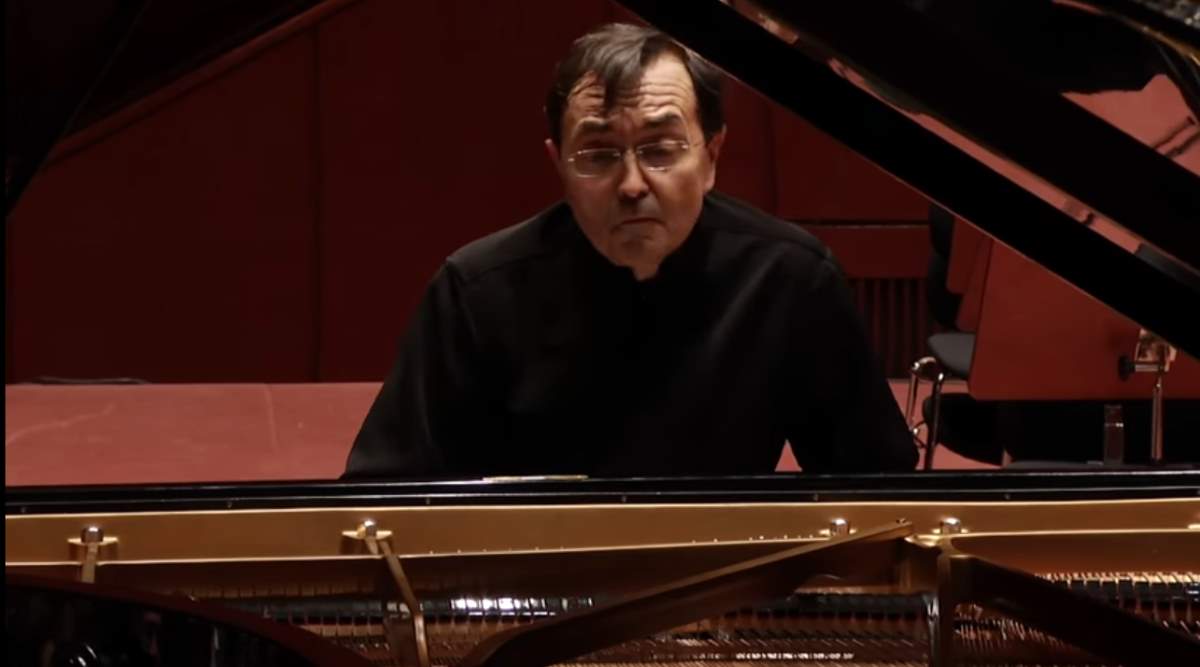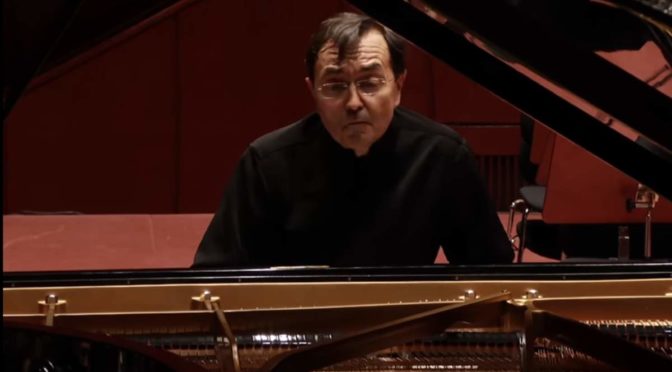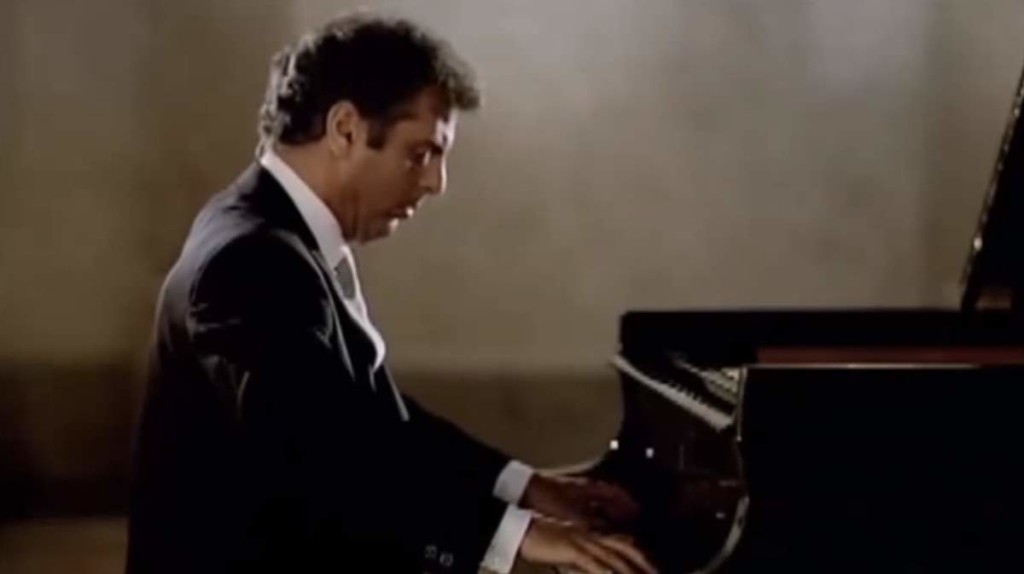French classical pianist Pierre-Laurent Aimard plays Ludwig van Beethoven’s Piano Sonata No. 23 in F minor, Op. 57 (popularly known as the Appassionata, meaning “passionate” in Italian), one of the greatest and most technically challenging piano sonatas of the composer. Recorded at Alte Oper Frankfurt on 12 February 2016. Published by the hr-Sinfonieorchester (Frankfurt Radio Symphony) channel.
The piece was composed during 1804 and 1805, and perhaps 1806. The first edition was published in February 1807 in Vienna. It was dedicated to Count Franz von Brunswick.
Eric Blom (20 August 1888 – 11 April 1959, the Swiss-born British-naturalised music lexicographer, musicologist, music critic, music biographer, and translator) notes that Beethoven was in love at the time with both of the Count’s two sisters – Therese von Brunswick, a placid maiden whose appeal was entirely spiritual, and Josephine von Deym, a spirited widow whose attraction was mostly physical. Blom speculates that the raging mood of the Appassionata reflects the duality of these inclinations that plagued Beethoven, and that the dedication to their brother was a discreet way of honoring his feelings.
Like many of his other sonatas, for example, like the “moonlight sonata“, the name appassionata was, not given to the work by Beethoven himself. It was actually the publisher of a four-hand edition that gave the Piano Sonata No. 23 the name it is most known by today.
Movements
There are three movements:
- Allegro assai A sonata-allegro form in 12/8 time, the first movement progresses quickly through startling changes in tone and dynamics, and is characterized by an economic use of themes. The main theme, in octaves, is quiet and ominous. It consists of a down-and-up arpeggio in dotted rhythm that cadences on the tonicized dominant, immediately repeated a semitone higher (in G flat). This use of the Neapolitan chord (in music theory, a Neapolitan chord, or simply a “Neapolitan” is a major chord built on the lowered second -supertonic- scale degree) is an important structural element in the work, also being the basis of the main theme of the finale. As in Beethoven’s Waldstein sonata, the coda is unusually long, containing quasi-improvisational arpeggios which span most of the (early 19th-century) piano’s range. The choice of F-minor becomes very clear when one realizes that this movement makes frequent use of the deep, dark tone of the lowest F on the piano, which was the lowest note available to Beethoven at the time.
- Andante con moto A set of variations in D flat major, on a theme remarkable for its melodic simplicity combined with the use of unusually thick voicing and a peculiar counter-melody in the bass. Its sixteen bars (repeated) consist of nothing but common chords, set in a series of four- and two-bar phrases that all end on the tonic. The four variations follow:
- Var. I: similar to the original theme, with the left hand playing on the off-beats.
- Var. II: an embellishment of the theme in sixteenth notes.
- Var. III: a rapid embellishment in thirty-second notes. A double variation, with the hands switching parts.
- Var. IV: a reprise of the original theme without repeats and with the phrases displaced in register.
The fourth variation cadences deceptively on a soft diminished-7th, followed by a much louder diminished seventh that serves as a transition to the finale.
- Allegro ma non troppo – Presto A sonata-allegro in near-perpetual motion in which, very unusually, only the second part is directed to be repeated. It has much in common with the first movement, including extensive use of the Neapolitan sixth chord and several written-out cadenzas. The movement climaxes with a faster coda introducing a new theme which in turn leads into an extended final cadence in F minor. According to Donald Francis Tovey this is one of only a handful of Beethoven’s works in sonata form that end in tragedy (the others being the C minor Piano Trio, Piano Sonata Op. 27 no. 2 (“Moonlight”), Violin Sonata Op. 30 no. 2, and the C# minor Quartet).
Pierre-Laurent Aimard

Pierre-Laurent Aimard (born 9 September 1957) is a French pianist. He was born in Lyon, where he entered the conservatory. Later he studied with Yvonne Loriod and with Maria Curcio.
In 1973, he was awarded the chamber music prize of the Paris Conservatoire. In the same year, he won the first prize at the international Olivier Messiaen Competition. In 1977, at the invitation of Pierre Boulez, he became a founding member of the Ensemble InterContemporain. He made his American debut with the Chicago Symphony Orchestra at the age of twenty, performing the piano solo part in Olivier Messiaen’s Turangalîla-Symphonie.
Aimard is particularly committed to contemporary music. He was the soloist in several premieres of works such as Répons by Pierre Boulez, Klavierstück XIV by Karlheinz Stockhausen, and the eleventh and thirteenth piano études of György Ligeti. One of his most notable recordings is that of the first two books of Ligeti’s piano études. He has also performed the work of contemporary composers such as George Benjamin and Marco Stroppa. In May 2012, he premiered Tristan Murail’s piano concerto Le Désenchantement du Monde.
In addition to his work with contemporary music, Aimard has recorded the five Beethoven piano concertos with Nikolaus Harnoncourt and the Chamber Orchestra of Europe, at the invitation of Harnoncourt. Aimard has recorded for the Sony Classical and Teldec labels. In August 2007, he signed a new recording contract with Deutsche Grammophon.
In 2009, Aimard became the Artistic Director of the Aldeburgh Festival in England, for an initial contract of 3 years. Aimard is a visiting professor and an Honorary Member (2006) of the Royal Academy of Music. He appears in the 2007 film Note by Note: The Making of Steinway L1037.
Aimard was featured recording Bach’s The Art of Fugue in the 2009 award-winning German-Austrian documentary Pianomania, about Steinway & Sons’ piano technician Stefan Knüpfer, which was directed by Lilian Franck and Robert Cibis. The film premiered theatrically in North America, where it was met with positive reviews by The New York Times, as well as in Asia and throughout Europe, and is a part of the Goethe-Institut catalogue.
Sources
- Piano Sonata No. 23 (Beethoven) on wikipedia
- Sonata No. 23 in F minor, Op. 57, “Appassionata” on classicalconnect.com
- Piano Sonata No. 23, “Apassionata” on ClassicalNotes.net
- Pierre-Laurent Aimard on wikipedia.com
- pierrelaurentaimard.com

